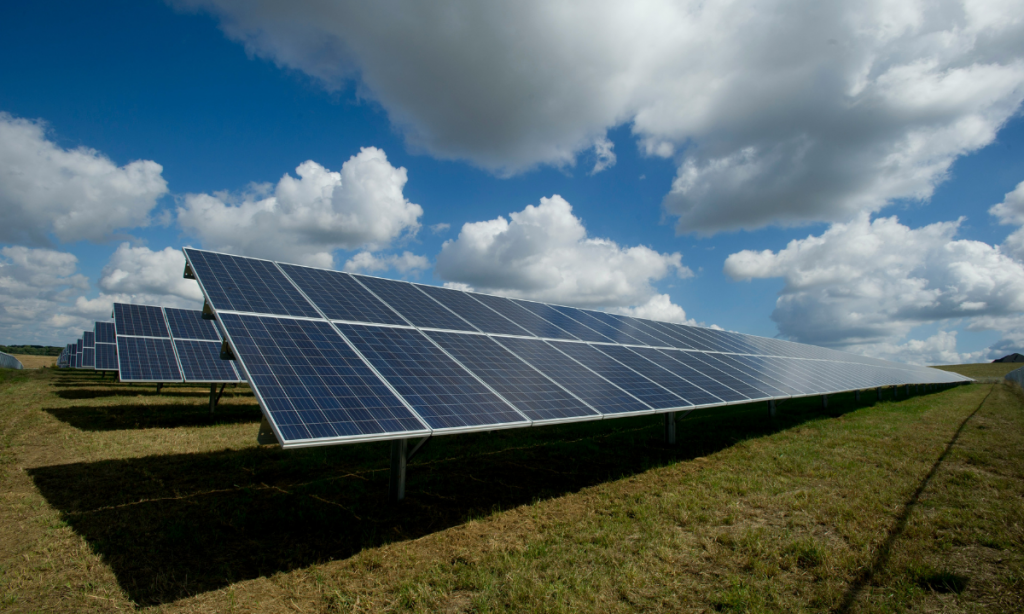Why Isn’t There More Renewable Energy on the Grid?
November 21, 2024

Renewable energy is more environmentally friendly and oftentimes cheaper than fossil fuels, yet power grids across the nation still rely heavily on fossil fuels. Vanderbilt Law held a discussion to address the issue with Bradley attorney Chris Bowles ‘08, Silicon Ranch Co-Founder Matt Kisber BA’82, and Judge Jim Rossi, the D. L. Lansden Chair in Law. J.B. Ruhl, the David Daniels Allen Distinguished Chair in Law and Co-Director of the Energy, Environment and Land Use Program, moderated the discussion which asked “why isn’t there more renewable energy on the grid?”
One of the greatest sources of opposition to renewable energy implementation is local and state regulation, and the group talked about how this and other factors have resulted in the slow integration of solar energy into power grids.
Bowles, a partner in the Renewable Energy Group at Bradley, deals primarily with development and finance for renewable energy projects. For him, the problem of implementation boils down to five pressure points: Interconnection to the grid, siting, off-take, procurement, and capital.
Kisber served in the Tennessee State House of Representatives for 20 years before becoming the Commissioner of Economic and Community Development under Governor Bredesen. After eight years in that role, he co-founded Silicon Ranch, an independent, fully integrated solar power producer.
“We believe that the value in developing these projects is in the long-term ownership and in that interconnection, especially as those interconnections become more scarce,” Kisber said.
Local and state regulations can pose a major obstacle to business. “With over 5,000 local and state jurisdictions, and having to deal with the unique codes and ordinances of each one, it becomes a bespoke exercise in trying to get permitting and trying to get land use certificates to bring a project to construction and ultimately to completion,” he said.
Silicon Ranch has found success in creating solar plants, including a recent partnership with Vanderbilt, but it took over a billion dollars in institutional investments to raise the capital necessary to support the company’s development pipeline.
For Rossi, one of the top-20 most-cited administrative and/or environmental law faculty in the United States, the backdrop for conversations around the energy industry is the current “vertical infrastructure,” wherein a single entity provides power generation, distribution, and transmission according to Rossi.
Roughly 2/3 of the country’s energy markets are strictly organized, but the rest is open to independent developers.
“In other parts of the country, including most of the Southeast, we have traditional, regulated markets, but we also open things up quite a bit to these independent developers,” Rossi said. “Independent power producers who are non-utilities, who can take a risk and make the investment to build a project.”
However, independent producers still face many roadblocks in the parts of the country that do allow independent contractors.
“In some ways, it’s surprising anything gets built,” Rossi said. “If we were to conceptualize a project today, it would still take us 5-10 years under very good conditions to get that project built.”
The issue for the aforementioned two-thirds of the country boils down to long-term power purchase agreements. While purchase agreements allow for a reliable revenue stream to finance projects, they do not exist in most places.
The plants that are created face another obstacle: land. Solar plants take up lots of space, but the land must also be optimally located near existing transmission assets, which are owned by vertically integrated utilities.
“The interconnection alone, in terms of cost, can be in the tens of millions to sometimes hundreds of millions that you have to incur just to get the project connected to the grid,” Rossi said. “These lines are typically owned by a utility that has a strong interest in doing what it can to manage the queue … That can be a big challenge, making sure that your project is in that queue.”
The transmission problem is one that will be paramount over the coming decades, according to Rossi.
“If we’re to move transmission forward—what we need to do with clean energy—this is a massive expense item that we’ll need to confront over the next couple of decades,” Rossi said. “[We’re] trying to think about ways of designing the network so that we can get better, more flexible access to transmission in the future.”
Public attitudes
A recent bill proposed by Senators Joe Manchin and John Barrasso seeks to accelerate the energy permitting process at the federal level. However, more localized barriers would still be at play, according to Kisber.
Support for renewable energy has risen over the past few years, however some still oppose it due to inaccurate information or poor experiences with companies in the past.
“We [Silicon Ranch] have gone into a handful of communities where a previous developer has not acted consistent with the community standards and have upset a lot of people,” Kisber said.
This results in local councils putting in unreasonable requirements that make renewable energy developments impractical. Kisber combats this by being transparent about lead times to mitigate expectations and maintain positive community relations.
Bowles followed Kisber by talking about perceptions on the state level.
“I will say the Tennessee General Assembly, wittingly or unwittingly, has actually done some really good things for solar in recent years,” Bowles said. “We have passed three bills in the last two sessions, all of which had some positive impact.”
Nonetheless, solar energy still faces opposition on the state level from some, according to Bowles.
Physical challenges
Solar’s lack of reliability is another obstacle to its adoption, but it is currently the lowest cost form of energy production. Kisber believes solar plays a specific role in energy production: stocking energy supplies.
“Our customers are utilities and oftentimes a large customer—a utility or a data center for instance,” Kisber said. “The contracts of the last five or six years that we’ve been doing … Those are energy supply.”
Another benefit of solar, besides keeping average energy costs for big consumers down, is creating tax revenues for rural communities. Kisber recounted a story about a county Silicon Ranch worked with that had not experience a significant economic development since the 1950s.
“In that county, the tax revenue generated by our investment, which was about 90 million dollars, enabled them to give a thousand dollar pay raise to every school teacher, buy new playground equipment, and have some leftover revenues,” he said.
Search
RECENT PRESS RELEASES
Related Post




